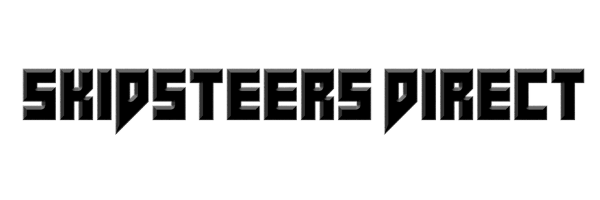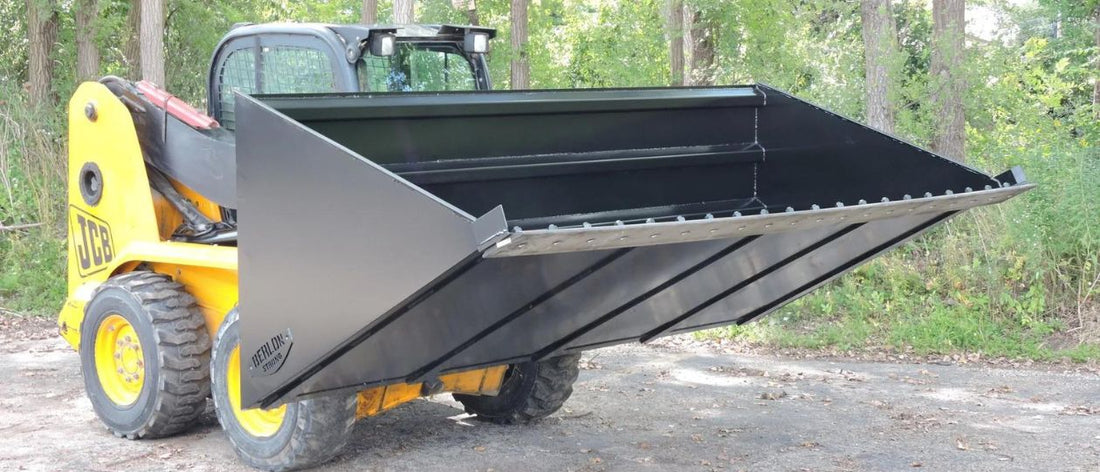
Choosing The Right Skid Steer Bucket Size
Share
Most experienced skid steer operators will tell you that a skid steer bucket isn't a one size fits all attachment. Far from it in fact.
The size of your skid steer bucket should not only be matched up to the dimensions and capabilities of your skid steer, but it should also have the intended job in mind. Your high capacity snow bucket may not be a great attachment for moving gravel after all!
In this article, we are going to look how to choose the right size bucket for your skid steer or mini skid steer. Stay tuned!
Cover Your Tracks - How Wide Should My Skid Steer Bucket be?

Starting with the easiest part first, let's look a how wide your skid steer bucket should be. And the easiest answer is - it should cover track/wheel base.
A skid steer with a bucket that is narrower than its host machine wheel base will not only have less traction when pushing into a material pile, it will also have a tendency to compact the material pile as the tires roll over the loose material that's left on the edges of the bucket.
To complicate matters further, for those of us who still grade with a bucket, leaving wheel tracks on the outside of the bucket makes grading more difficult.
For this reason, we recommend always purchasing a loader bucket that is slightly wider than your track/wheel base. For example, a Bobcat T550 has an approximate track base of 67", so a 72" bucket should be considered.
Material Weight & Bucket Capacity
Buckets should be sized with its intended material in mind. That's why manufacturers go out of their way to manufacturer light material buckets, general purpose buckets, and heavier lifting low profile buckets.
If you are looking at purchasing a new loader bucket for a specific job, it's a good idea to know the weight of the material your are going to be working with. You can then mathematically determine which skid steer buckets are the best option for you.
Let's have a look at some common material weights.
Common Material Weights

Gravel
-
90-130 lbs per cubic foot
Earth
-
Dry and loose 76 lbs per cubic foot
-
Wet and packed 115 lbs per cubic foot
Sand
-
Dry 90 to 100 lbs per cubic foot
-
Wet 125 lbs per cubic foot
Snow
-
15 lbs per cubic foot when dry
-
50 lbs per cubic foot when wet
Calculating The Capacity Of A Skid Steer Bucket

Now that we know the weight of common materials used with skid steer buckets, we can determine how much the material will weigh when the bucket is loaded.
This is an important consideration for both large a small skid steers. On one hand, we don't want to overload a small skid steer and risk damage or tipping. On the other hand, we don't want to under load a large skid steer, making it inefficient and slower to get jobs done.
We will calculate bucket capacity in cubic feet, by first determining the struck capacity, and then adding a multiple for heaped capacity.

Struck Capacity
The struck capacity of a skid steer bucket is best thought of as the "level capacity". This is the bucket capacity without heaping.
Right now you'r probably thinking "I'm always going to heap material in my bucket, so why should I bother worrying about the level capacity?" You are right to think that, but we need it as a starting point to figure out the heaped capacity.
Calculation:
- Measure from the top of the bucket, straight down to the bottom in inches. This gives us the bucket "height".
- Measure from the front of the cutting edge horizontally to the back of the bucket in inches. This gives us the bucket "floor".
- Height x Floor ÷ 2 x width of bucket = struck capacity in cubic inches
- Struck Capacity in Cubic inches ÷ 1728 = Struck capacity in cubic feet.
Heaped Capacity
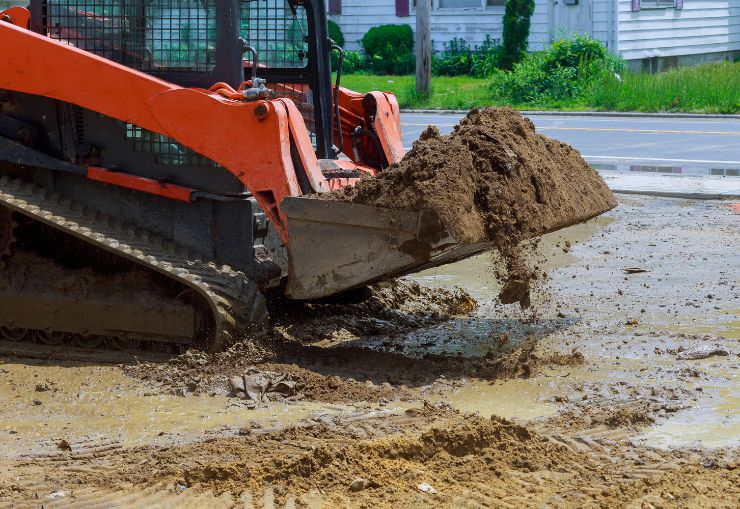
Now that we know the struck capacity of our skid steer bucket, we can calculate the heaped capacity. The heaped capacity of a bucket, as the name suggests, is how much material the bucket is holding when it is heaped up to it's maximum.
A buckets heaped capacity isn't a direct science, but instead is a very close estimation. It may vary slightly depending on the design of the bucket, as well as the material. For all intents and purposes, our calculation below will be close enough.
To perform this calculation, we first determine the heaped amount, and then add it to the struck capacity.
Calculation
-
Struck Capacity ÷ 3 = Heaped Amount in Cubic feet
-
Heaped amount in cubic feet + Struck Capacity in cubic feet = Heaped Capacity in Cubic feet
Example - Bobcat S150 Bucket Moving Dry Snow
Here is an example. Let's figure out the ideal bucket size for a Bobcat S150 moving dry snow.
According to Ritchie Specs, a Bobcat S150 has a 1,500 pound lifting capacity, and is 66" wide at the wheel base.
Choosing a Snow Bucket
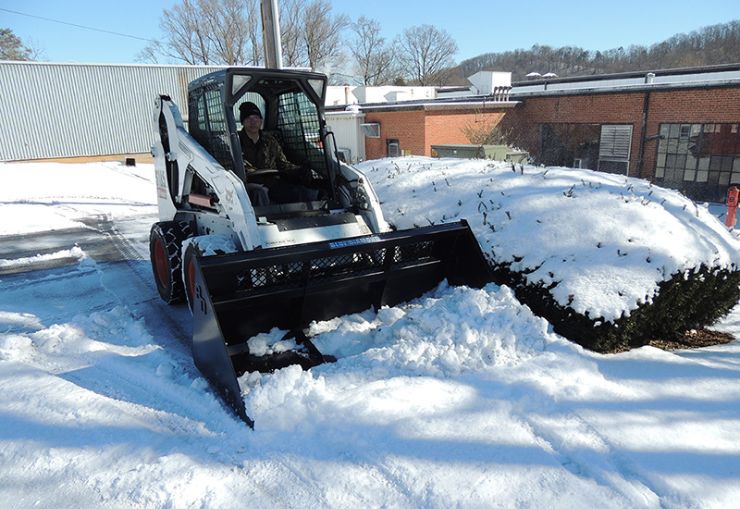
We know that we need to cover the skid steer loaders wheel base in order to not compress snow on the outside of the bucket, and we also know that dry snow is typically around 15 pound per cubic foot. For this reason we are going to first look at a 72" wide High Capacity Snow Bucket from Berlon Industries
We start by calculating the struck capacity, by using the formula above.
-
The bucket height measures 31"
-
The bucket floor measures 41"
-
Height (31") x floor (41") ÷ 2 x width of bucket (72") = Struck Capacity in Inches (45,756")
-
Struck capacity in cubic inches (45,756) ÷ 1728 = struck capacity in cubic feet (26.5 cubic feet).
Next we determine the heaped capacity of the bucket.
-
Struck Capacity in cubic feet (26.5) ÷ 3 = heaped capacity (8.8 cubic feet)
-
Struck Capacity in cubic feet (26.5) + Heaped Capacity in Cubic Feet (8.8) = Heaped Capacity (35.3)
Lastly we multiple the heaped capacity of our bucket to the material weight we intend on working with. We can then add the weight of the bucket to the final figure to ensure we are within the operating range of the skid steer.
- Heaped Capacity (35.3) x Dry Snow Cubic Foot Weight (15 pounds per cubic foot) = Working weight of the bucket (530 pounds).
- Weight of materials (530 pounds) + weight of bucket (592 pounds) = total operating weight (1,122 pounds).
From this we can see that when clear dry snow with Berlon's 72" High Capacity Snow Bucket, we will be lifting a maximum of roughly 1,122 pounds, nicely within the the skid steers design specifications.
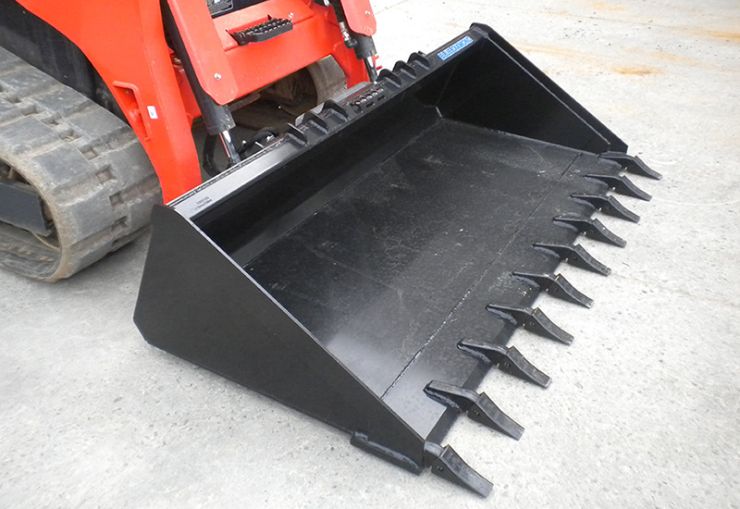
Conclusion
The key to efficiency is attention to details..
Understanding how to get the most out of your skid steer loader and its attachments is often the difference between being profitable with a skid steer or not.
If you have any further questions about sizing up your next skid steer bucket, reach out to us, and we would be happy to help.

